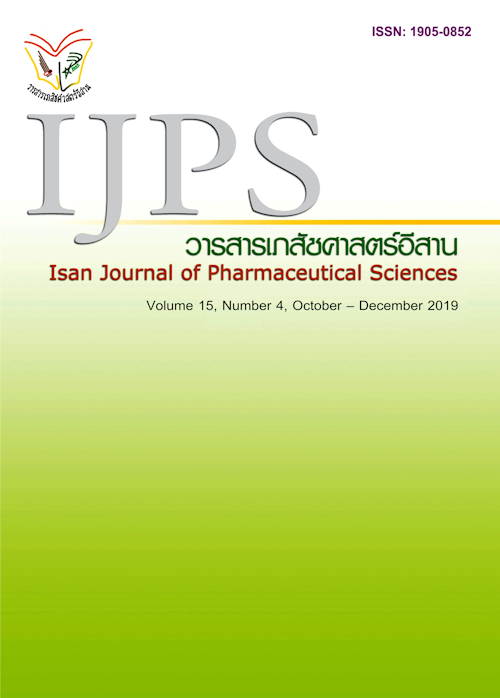Medical Uses of Cannabis
Main Article Content
Abstract
Cannabis is a tropical plant in Cannabaceae family that can grow in a warm climate such as Thailand. Cannabis is considered as a narcotic plant that was traditionally aimed for therapeutic use in several diseases. But with its habit forming effect, cannabis was reframed for medical uses for quite some time. Among with various modulatory effects of cannabinoids on body functions, two major cannabinoids are known to be used as medicines. They are a psychoactive compound THC (delta-9-tetrahydrocannabinol) and a non-psychoactive compound CBD (cannabidiol). Currently, THC and CBD are advised to be used for treatment of a variety of medical conditions such as neuropathic pain, muscle spasticity, epilepsy, nausea and vomiting as well as loss of appetite. Both of these substances exert their activities by modulating body functions and maintain homeostasis via endocannabinoid receptors. This article aimed to provide an up to date information related to appropriate uses of cannabis as medicines. The content of this article consists of botanical characteristics, history of medical uses, active components of cannabis, endocannabinoid system, pharmacology and mechanism of action, product types, pharmacokinetics, drug interaction, adverse effects and toxicity of cannabinoids. Although, potential benefit can be found in the medical condition above mentioned. The use of cannabis in some disease states such as cancer, Parkinson, and Alzheimer's disease remain to be clinically evaluated in both efficacy and safety aspects through systematic research before being generalized for routine use.
Article Details
In the case that some parts are used by others The author must Confirm that obtaining permission to use some of the original authors. And must attach evidence That the permission has been included
References
Abel EL. Marijuana: The First Twelve Thousand Years. Springer, 1980, New York, USA.
Akhtar MT, Shaari K, Verpoorte R. Biotransformation of Tetrahydrocannabinol. Phytochem Rev. 2016;15:921-934.
Aldrich M. History of therapeutic cannabis. In: Mathre, M.L. (Ed.), Cannabis in Medical Practice: A Legal, Historical and Pharmacological Overview of the Therapeutic use of Marijuana. McFarland & Co., Jefferson, NC, and London, 1997, pp. 35–55.
Jiang HE, Li X, Zhao YX, et al.. A new insight into Cannabis sativa (Cannabaceae) utilization from 2500-year-old Yanghai Tombs, Xinjiang, China. J Ethnopharmacol. 2006; 108: 414–422.
O'Shaughnessy WB. On the preparations of the Indian hemp, or Gunjah. Prov Med J Retrosp Med Sci. 1843; 5: 363–369.
Hill AJ, Williams CM, Whalley BJ, Stephens GJ. Phytocannabinoids as novel therapeutic agents in CNS disorders. Pharmacol Ther. 2012; 133(1): 79-97.
Bonini SA, Premoli M, Tambaro S, et al.. Cannabis sativa: A comprehensive ethnopharmacological review of a medicinal plant with a long history. J Ethnopharmacol. 2018; 5: 227:300-315.
Chen JW, Borgelt LM, Blackmer AB. Cannabidiol: a new hope for patients with Dravet or Lennox-Gastaut syndromes. Ann Pharmacother. 2019; 53(6): 603-611.
Epidiolex® (Cannabidiol) prescribing information. Carlsbad, CA: Greenwich Biosciences, Inc.; 2018.
Fraguas-Sánchez AI, Martín-Sabroso C, Torres-Suárez AI. Insights into the effects of the endocannabinoid system in cancer: a review. Br J Pharmacol. 2018; 175(13): 2566-2580.
Grotenhermen F. Pharmacokinetics and pharmacodynamics of cannabinoids. Clin Pharmacokinet. 2003; 42: 327-360.
Heuberger JA , Guan Z , Oyetayo OO, et al.. Population pharmacokinetic model of THC integrates oral, intravenous, and pulmonary dosing and characterizes short- and long-term pharmacokinetics. Clinical Pharmacokinetics. 2015; 54(2): 209-219.
Huestis MA. Human cannabinoid pharmacokinetics. Chem Biodiver. 2007; 4: 1770-1804.
Lucas CJ, Galettis P, Schneider J. The pharmacokinetics and the pharmacodynamics of cannabinoids. Br J Clin Pharmacol. 2018; 84(11): 2477-2482.
Manini AF, Yiannoulos G, Bergamaschi MM, et al.. Safety and pharmacokinetics of oral cannabidiol when administered concomitantly with intravenous fentanyl in humans. J Addict Med. 2015; 9: 204-210.
Martin-Santos R, Crippa JA, Batalla A, et al.. 2012. Acute effects of a single, oral fose of d9-tetrahydrocannabinol (THC) and cannabidiol (CBD) administration in healthy volunteers. Curr Pharmaceutic Design. 2012; 17: 4966-4970.
National Academies of Sciences, Emerging and Medicine, Report. The Health Effects of Cannabis and Cannabinoids, The National Academies Press, 2017, Washinton DC, USA.
Niaz K, Khan F, Maqbool F, et al.. Endo-cannabinoids system and the toxicity of cannabinoids with a biotechnological approach. Excli J. 2017; 16: 688-711.
O’Brien K. Medical cannabis: issues of evidence. Eur J Integr Med. 2019; 28: 114-120.
Opitz BJ, Ostroff ML, Whitman AC. The potential clinical implications and importance of drug interactions between anticancer agents and cannabidiol in patients with cancer. J Pharm Pract. 2019; 18: 897190019828920.
Prandi C, Blangetti M, Namdar D, Koltai H. 2018. Structure-activity relationship of cannabis derived compounds for the treatment of neuronal activity-related diseases. Molecules. 2018; 23(7): E1526.
Piluzza G, Delogu G, Cabras A, Marceddu S, Bullitta S. Differentiation between fiber and drug types of hemp (Cannabis sativa L.) from a collection of wild and domesticated accessions. Genet Resour Crop Evol. 2013; 60: 2331–2342.
Russo EB, Jiang HE, Li X, et al.. Phytochemical and genetic analyses of ancient cannabis from Central Asia. J Exp Bot. 2008; 59: 4171–4182.
Schwilke EW, Schwope DM, Karschner EL, et al.. Delta9-tetrahydrocannabinol (THC), 11-hydroxy-THC, and 11-nor-9-carboxy-THC plasma pharmacokinetics during and after continuous high-dose oral THC. Clin Chem. 2009; 55(12): 2180-2189.
Silote GP, Sartim A, Sales A, et al.. Emerging evidence for the antidepressant effect of cannabidiol and the underlying molecular mechanisms. J Chem Neuroanat. 2019; 98: 104-116.
Ujváry I, Hanuš L. Human metabolites of cannabidiol: a review on their formation, biological activity, and relevance in therapy. Cannabis Cannabinoid Res. 2016; 1(1): 90-101.
White CM. A review of human studies assessing cannabidiol's (CBD) therapeutic actions and potential. J Clin Pharmacol. 2019; 59(7):923-934.
World Health Organization (WHO), Expert Committee on Drug Dependence. Fortieth Meeting. Cannabidiol (CBD) Critical Review Report, World Health Organization, Geneva, 4-7 June 2018.
Zou S and Kumar U. Cannabinoid receptors and the endocannabinoid system: signaling and function in the central nervous system. Int J Mol Sci. 2018; 19(3)i: E833.


